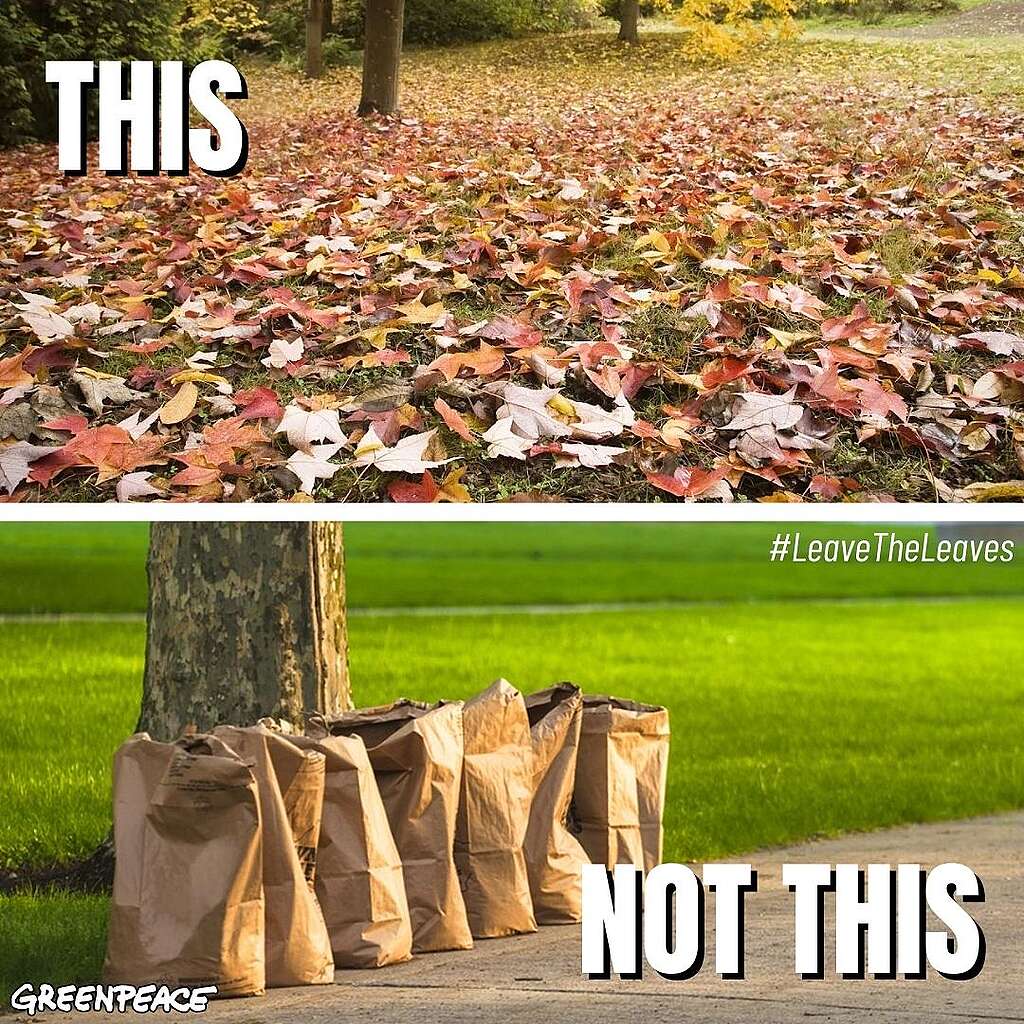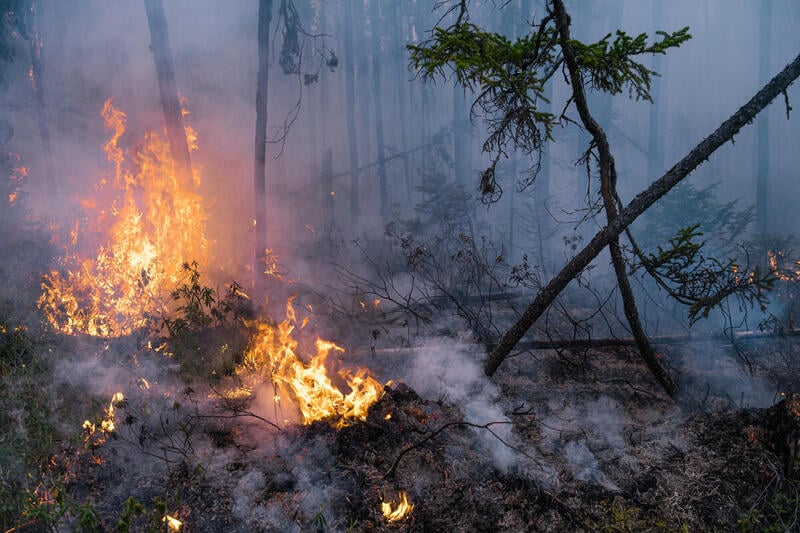Your yard is a universe: less mowing in the spring and less cleanup in the fall can help protect the birds, bees and butterflies that call your yard home.

Rake, mow, and blow. It’s an autumn ritual that keeps many a lawn as clean and cropped as a golf course, even as the leaves fall. For many in our culture, a tidy leafless lawn has become a cultural norm: we don’t think too much about pulling out the leaf blower, sending bagged leaves to the curb or chopping them to bits with a lawn mower – because that’s just what we do. But what if maintaining immaculate green squares collides with the needs of precious pollinators, insects and birds that need shelter and food in cold winter months in order to survive?
Maybe it’s time to challenge our leafless ways.
Many of us by now have heard of #NoMowMay – a campaign dedicated to holding off on mowing the lawn or permanently mowing less while growing native plants and flowers to better support the bees, birds and butterflies. But have you heard of #LeaveTheLeaves – the fall counterpart?
This year, why not consider leaving some of those leaves on the lawn and waiting until the spring to clean up your garden? Not only will you save time, but you’ll give a winter home to precious, at-risk pollinators, along with a host of other animals.

Why is leaving the leaves a big deal?
The glorious variety of life on this earth is under threat from pollution, industrial exploitation, climate change, and waves of extinctions. Biodiversity is in crisis. It will take governments, implementing strong nature protection laws, to safeguard all the plants and animals that are so crucial to thriving ecosystems.
But leaving the leaves and waiting until late spring to clear away dried garden debris is one small way individuals can take action — right in their backyards — to help ecosystems flourish.
Who will be sheltering in your leaves this winter?
During the colder months, a community of animals use leaves and garden materials for food, insulation from the cold, and nurseries for eggs, larvae, and pupae. When you clear away your leaves and cut back your garden in the fall, you may be destroying their current or future homes.
Here are just a few of the creatures that could be sleeping, creeping, growing, crawling, and sheltering in your leaves and garden over the winter:
? Bee populations are declining around the world due, in part, to a lethal mix of habitat loss, disease, climate change, and pesticides. Why not create more safe spaces in your yard for these threatened pollinators? During the winter, mated queen bumble bees hibernate in small holes underground, with thick leaves offering them protection from the elements. And before winter comes, many bees native to Canada, such as leafcutter and mason bees, nest and lay their eggs in the ground or in hollow plant stems or wood so that young can emerge in spring.

? Butterflies and moths that don’t migrate to warmer places during the winter spend the cold months as eggs, caterpillars, pupae, or adults. Great spangled fritillary and woolly bear caterpillars bury into leaves for protection from the cold and predators. Luna moths and swallowtail butterflies camouflage their cocoons and chrysalises as dried leaves, hidden among the real leaves.

? Most ladybugs spend the colder months hibernating, sometimes under leaves or rocks. They might be joined by the adults, eggs, or pupae of assassin bugs, lacewings, big-eyed bugs, minute pirate bugs, damsel bugs, spiders, millipedes, snails, worms, frogs, and more.
? Leaving flower heads and shrubs full of seeds and fruits gives winter songbirds, including chickadees, goldfinches, and blue jays, food during a lean season. Once spring comes, birds also use old flower stems and grasses to build nests.

The best strategies for leaving your leaves
In some areas, leaving the leaves completely untouched is just not possible. Heavy amounts of leaf layer can cause mold and rot, damaging the plants underneath. If your leaf layer is thick, don’t worry – there are still ways to leave the leaves: you don’t have to leave them exactly where they are to participate and support overwintering wildlife.
What should you do with extra leaves? Shun those air and noise polluting leaf blowers and rake the leaves into garden beds or add them to a compost pile. You can also rake some of them into thin piles around the base of tree trunks. Just ensure that they are only around 3- to 6-inch deep piles and leave a ring at least 3–4 inches from the trunk free of leaves.
Avoid shredding the leaves with a lawn mower: shredding leaves can destroy insects, cocoons, chrysalises and eggs that are using the leaf layers for cover or incubation. If the layer seems too thick or is problematic for the specific plants in your garden, you might shred some leaves to reduce volume and keep the rest whole, or redistribute whole leaves to certain areas of your property. Both shredded and whole leaves will provide insulation for insects that hibernate below ground (but whole is best).
While you’re protecting the little universe on your lawn, you can also wait until later in the spring to prune and clean up your garden, after most animals that overwintered there have emerged.
Leaving leaves and garden materials where they can decompose naturally doesn’t just benefit the creatures living there. It also adds rich nutrients to the soil. These nutrients nourish tree roots, along with the grass and garden. In the forest, leaves provide 50–80% of the nutrients trees receive while protecting the levels of moisture that reach the trees and also regulating the soil temperature. They also feed a vast number of microbes — the tiny but powerful life forms that keep your soil, and the plants that rely on it, healthy.
Leaves are not litter! Let’s make wild yards the new normal.

“Instead of this perfectly manicured, untouchable space, think of it as this living, breathing habitat. And when you start thinking about it that way, you’re going to start seeing that the more that you do stuff like this, the more birds are going to be attracted to your yard, diversity of birds, insects, butterflies. And with this leaf cover, come spring, it’s going to go into the ground. So you’re going to have your nice green lawn again.” – Melissa Hopkins of the National Audubon Society, Want To Improve Your Lawn? Don’t Bag Those Leaves

How else can you protect pollinators and boost biodiversity?
Of course, you and your yard alone cannot fix the biodiversity crisis or defend nature from all the exploitative industries that continue extracting more and more from life-giving waterways, old growth forests, and Indigenous territories. The federal government must do its part. Canada needs a strong Nature Protection Act right now to shelter plants and animals from coast to coast.
We need Canada’s government to pass a strong Nature & Biodiversity Act. Join the campaign now.
Got another minute? Take this fun pollinators quiz to see what you might have in common with one or more of the incredible wild pollinators across Canada.

This article was updated on May 15th, 2024.

The environment minister must pass legislation that respects Indigenous rights and safeguards biodiversity.
Take action


Discussion
Dear Greenpeace, please be a bit more specific with your campaign. It's important to remove litter and tidy the edges and remove debris from the road, sidewalk, bike lanes, curbs, pathways and steps. As well as trim back growth from manmade objects. You can incorporate the tips of 'No Mow and Tidy Property Maintenance' (Facebook page link) into your campaign. As there are reasons why some would be hesitant to leave the leaves.